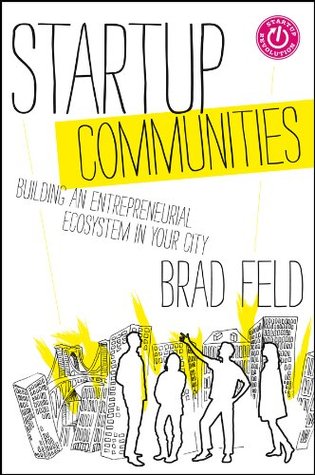More on this book
Community
Kindle Notes & Highlights
by
Brad Feld
Read between
June 27 - July 13, 2014
college town, full of smart, independently minded, and intellectually curious people.
I failed more often than I succeeded.
small amount of money in 10 of them at a time, putting them through an intense 90-day program during which they worked closely with mentors and other angel investors to get their businesses to the next stage, at which point they’d be ready to raise a full angel round.
Boulder regularly tops many of the best-of lists for a wide variety of topics, including most creative, happiest, healthiest, smartest, and best quality of life (http://startuprev.com/g1
“give before you get” mentality that leads to strong collaboration,
None, however, has come close to producing anywhere near the volume of successful startups, especially on a per-capita basis, as Boulder.
Boulder’s startup ecosystem have a greater sense of community than anywhere else in the country.
job-creation engines our country has ever seen.
there was no strategic plan.
Boulder caught fire because a few dozen entrepreneurs believed in their hearts that a rising tide lifts all boats and they derived great pleasure from helping make that happen.
the magic comes from a few dozen entrepreneurs deciding that the success of the greater startup community is worth their investment of time and energy.
The investigation into startup communities is among the most important inquiries of our time.
Studies show that the geography of innovation is neither democratic nor flat.
Evidence suggests that location, rather than being irrelevant, is more important than ever.
external or agglomeration economies,
Companies in a common geographic area share the fixed costs of these resources external to the company.
network effects make co-location more valuable.
persuasively argues that a culture of openness and information exchange fueled Silicon Valley’s ascent over Route 128.
tie between innovation and creative-class individuals. The creative class is composed of individuals such as entrepreneurs, engineers, professors, and artists who create “meaningful new forms.”
They are incomplete, however, concerning how to put a startup community into motion.
challenging to explain how to get a startup community up and running.
Entrepreneurs must lead the startup community. 2. The leaders must have a long-term commitment. 3. The startup community must be inclusive of anyone who wants to participate in it. 4. The startup community must have continual activities that engage the entire entrepreneurial stack.
The most critical principle of a startup community is that entrepreneurs must lead it.
organizations try to play a leadership role
Although their involvement is important, they can’t be the leaders. The entrepreneurs have to be leaders.
entrepreneur as someone who has co-founded a company.
Because of this intense focus, it’s unrealistic to think that all entrepreneurs in a community will be leaders. All that is needed is a critical mass of entrepreneurs, often less than a dozen, who will provide leadership.
These leaders have to make a long-term commitment to their startup community. I like to say this has to be at least 20 years from today
A startup community must be extremely inclusive.
startup community is not a zero-sum game in which there are winners and losers; if everyone engages, they and the entire community can all be winners.
communities must have regular activities that engage the entire entrepreneurial
includes first-time entrepreneurs, experienced entrepreneurs, aspiring entrepreneurs, investors, mentors, employees of startups, service providers to startups, and anyone else who wants to be involved.
Leaders of startup communities have to be entrepreneurs.
There is no “leader of the leaders.” The best startup communities are loosely organized and consist of broad, evolving networks of people.
feeders thought of themselves as leaders. This has been one of the primary inhibitors of the long-term growth and evolution of many startup communities.
startup community wouldn’t be successful over the long term without both leaders and feeders. However, the absence of entrepreneurs as leaders, or the overwhelming leadership by feeders, will doom a startup community.
If less than half the audience consists of entrepreneurs, there is a fundamental problem.
well known that government can inhibit business activity.
Although a university presence is valuable to a startup community, I reject the premise that the startup community is dependent on the university.
Students are by far the most important contribution of a university to a startup community.
often the professors merely create a context for an independent thinker to come up with something new and amazing.
Many universities have entrepreneurship programs. These programs are often located in the business school, which is exactly the wrong place for them.
Forward-looking universities realize this and put the entrepreneurship center on the other side of campus from the business school.
TTOs are helpful
in many situations they are toxic because of absurd licensing terms;
excessive requests for equity or royalties; difficult licensing and contracting practices; and overreaching, restrictive IP p...
This highlight has been truncated due to consecutive passage length restrictions.
Embrace and include the university, but don’t rely on it to lead.
Many investors forget that the entrepreneurs are doing all the really hard work.
Fred Wilson at Union Square Ventures immediately comes to mind.
An advisor has an economic relationship with the company he is advising. In contrast, a mentor doesn’t.


